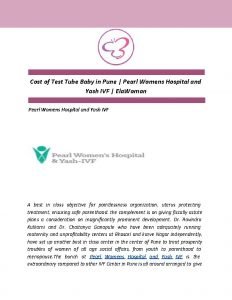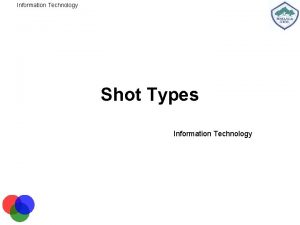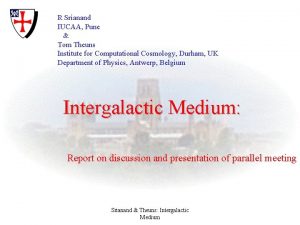International Institute of Information Technology Pune Department of





![Example %{ #include <stdio. h> %} %% [0123456789]+ printf("NUMBERn"); [a-z. A-Z][a-z. A-Z 0 -9]* Example %{ #include <stdio. h> %} %% [0123456789]+ printf("NUMBERn"); [a-z. A-Z][a-z. A-Z 0 -9]*](https://slidetodoc.com/presentation_image_h2/c9c3850ea51a0e803919f408efe256f5/image-6.jpg)

![Pattern Matching Examples Expression abc* abc+ a(bc)? [abc] [a-z] [a-z] [-az] [A-Za-z 0 -9]+ Pattern Matching Examples Expression abc* abc+ a(bc)? [abc] [a-z] [a-z] [-az] [A-Za-z 0 -9]+](https://slidetodoc.com/presentation_image_h2/c9c3850ea51a0e803919f408efe256f5/image-8.jpg)







- Slides: 15

International Institute of Information Technology, Pune Department of Computer Engineering Systems Programming & Operating Systems Unit – III Case Study: Overview of LEX and YACC

LEX & YACC • What is Lex? • Lex is officially known as a "Lexical Analyser". • It's main job is to break up an input stream into more usable elements. • Or in, other words, to identify the "interesting bits" in a text file. • What is Yacc? • Yacc is officially known as a "parser". • In the course of it's normal work, the parser also verifies that the input is syntactically sound. • YACC stands for "Yet Another Compiler". This is because this kind of analysis of text files is normally associated with Prof. Deptii Chaudhari, I 2 IT, Pune writing compilers. 2

Prof. Deptii Chaudhari, I 2 IT, Pune 3

LEX Program Structure Definitions %{ C global variables, prototype, Comments %} Production Rules %% ------------------%% User Subroutine Section (Optional) Prof. Deptii Chaudhari, I 2 IT, Pune 4

• In the rules section, each rule is made up of two parts : a pattern and an action separated by whitespace. • The lexer that lex generates will execute the action when it recognizes the pattern. • The user subroutine section, consists of any legal C code. • Lex copies it to the C file after the end of the lex generated code. • Lex translates the Lex specification into C source file called lex. yy. c which we compile and link with lex library –ll. • Then we can execute the resulting program to check that it works as we expected. Prof. Deptii Chaudhari, I 2 IT, Pune
![Example include stdio h 0123456789 printfNUMBERn az AZaz AZ 0 9 Example %{ #include <stdio. h> %} %% [0123456789]+ printf("NUMBERn"); [a-z. A-Z][a-z. A-Z 0 -9]*](https://slidetodoc.com/presentation_image_h2/c9c3850ea51a0e803919f408efe256f5/image-6.jpg)
Example %{ #include <stdio. h> %} %% [0123456789]+ printf("NUMBERn"); [a-z. A-Z][a-z. A-Z 0 -9]* printf("WORDn"); %% • Running the Program $ lex example_lex. l gcc lex. yy. c –ll. /a. out Prof. Deptii Chaudhari, I 2 IT, Pune 6

Pattern Matching Primitives Metacharacter Matches. any character except newline n newline * zero or more copies of the preceding expression + one or more copies of the preceding expression ? zero or one copy of the preceding expression ^ beginning of line $ end of line a|b a or b (ab)+ one or more copies of ab (grouping) "a+b" literal "a+b" (C escapes still work) [] character class Prof. Deptii Chaudhari, I 2 IT, Pune 7
![Pattern Matching Examples Expression abc abc abc abc az az az AZaz 0 9 Pattern Matching Examples Expression abc* abc+ a(bc)? [abc] [a-z] [a-z] [-az] [A-Za-z 0 -9]+](https://slidetodoc.com/presentation_image_h2/c9c3850ea51a0e803919f408efe256f5/image-8.jpg)
Pattern Matching Examples Expression abc* abc+ a(bc)? [abc] [a-z] [a-z] [-az] [A-Za-z 0 -9]+ [ tn]+ [^ab] [a^b] [a|b] a|b Matches abc abccc. . . abc, abccc, abcccc, . . . abc, abcbcbc, . . . a, abc one of: a, b, c any letter, a through z one of: a, -, z one of: - a z one or more alphanumeric characters whitespace anything except: a, b a, ^, b a, |, b a, b Prof. Deptii Chaudhari, I 2 IT, Pune 8

Operation of yylex() • When lex compiles the input specification, it generates the C file lex. yy. c that contains the routine int yylex(void). • This routine reads the input string trying to match it with any of the token patterns specified in the rules section. • On a match associated action is executed. • When we call yylex() function, it starts the process of pattern matching. • Lex keeps the matched string into the address pointed by pointer yytext. • Matched string's length is kept in yyleng while value of token is kept in variable yylval. Prof. Deptii Chaudhari, I 2 IT, Pune 9

$ cc lex. yy. c -ll %{ $. /a. out Write a C program int com=0; #include<stdio. h> %} int main() %% { "/*"[^n]+"*/" {com++; fprintf(yyout, " "); } int a, b; %% /*float c; */ int main() printf(“Hi”); /*printf(“Hello”); */ { } printf("Write a C programn"); Comment=2 yyout=fopen("output", "w"); $ cat output yylex(); #include<stdio. h> printf("Comment=%dn", com); int main() return 0; { int a, b; } printf(“Hi”); Prof. Deptii Chaudhari, I 2 IT, Pune } 10

Lex Predefined Variables Prof. Deptii Chaudhari, I 2 IT, Pune 11

YACC • YACC is a parser generator that takes an input file with an attribute-enriched BNF (Backus – Naur Form) grammar specification. • It generates the output C file y. tab. c containing the function int yyparse(void) that implements its parser. • This function automatically invokes yylex() everytime it needs a token to continue parsing. Prof. Deptii Chaudhari, I 2 IT, Pune 12

Prof. Deptii Chaudhari, I 2 IT, Pune 13

Structure of YACC Program Definitions Context free grammar & action for each production %{ C global variables, prototype, Comments %} %% ------------------%% Subroutines/Functions Prof. Deptii Chaudhari, I 2 IT, Pune 14

Arithmatic. l %{ #include<stdio. h> #include "y. tab. h" extern int yylval; %} %% [0 -9]+ { yylval=atoi(yytext); return NUMBER; } [t] ; [n] return 0; . return yytext[0]; %% int yywrap() { return 1; } How To Run: $yacc -d arithmatic. y $lex arithmatic. l $gcc lex. yy. c y. tab. c $. /a. out Prof. Deptii Chaudhari, I 2 IT, Pune 15
 German language course in pune
German language course in pune Sri lanka institute of information technology
Sri lanka institute of information technology Mutiyanganaya
Mutiyanganaya Department of information technology
Department of information technology Department of electronics & information technology
Department of electronics & information technology E & it department odisha
E & it department odisha Welcome to pune
Welcome to pune Mbrojtja ne pune
Mbrojtja ne pune Pune, india, has tried to increase its rainfall by
Pune, india, has tried to increase its rainfall by Edictate
Edictate Flood control pune
Flood control pune Ddhs pune
Ddhs pune Rayat shikshan sanstha sadhana vidyalaya hadapsar
Rayat shikshan sanstha sadhana vidyalaya hadapsar Test tube baby cost in pune
Test tube baby cost in pune Stricture treatment in pune
Stricture treatment in pune Sciedge pune
Sciedge pune




























